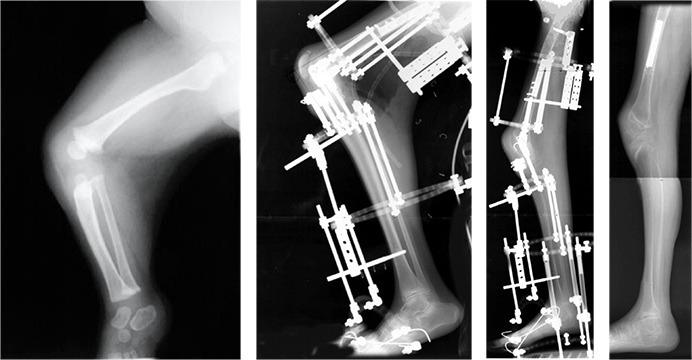At the Paley Institute we treat Popliteal Ptergyium Syndrome (PPS) with extensive soft tissue releases followed by shortening of the bone and then lengthening, casting, and extensive bracing. We have successfully treated many cases of this rare condition using a specialized new procedure, including:
- Radical Soft Tissue Releases
- Subtotal Fasciectomy including Fascia Lata
- Nerve Decompressions (sciatic, peroneal, posterior tibial)
- Hamstring & Gastrocnemius Recession or Z-Lengthening
- Shortening of the Bone
The primary difficulty in individuals with PPS is the severe flexion contracture of the knees. Individuals with PPS are unable to extend their knee straight or completely bend their knee. These extreme contractures not only inhibit gait but can also make it difficult for these patients to properly sit in a chair. The etiology of the knee flexion contracture in PPS is due to a variety of factors including:
- Capsular contracture
- Muscular contracture
- Hamstrings
- Gastrocnemius
- Skin contracture
- Fascia contracture
Dr. Paley will begin treatment with extensive soft tissue releases. This will include a subtotal fasciectomy including excision of the fascia lata (which is particularly tight in patients with PPS). After excision of the fascia, Dr. Paley will then resect the hamstrings and gastrocnemius muscles, or perform a z-lengthening of these structures.
Soft tissue releases are an important facet to correction of knee flexion contracture; however there is often adaptive contracture of the nerves and joint capsule in PPS. During the soft tissue releases Dr. Paley will perform multiple nerve decompressions (sciatic, peroneal, posterior tibial) in order to protect these structures. In order to address the capsular contractures, there are two solutions:
- Gradual Distraction of the Joint
- Shorten Bone
Dr. Paley used to treat PPS with gradual distraction of the joint using external fixation. However, this method often resulted in soft tissue “rebound” in which patients gradually lose their increased range of motion after distraction. Furthermore, gradual distraction immobilizes the joint for too long.

Dr. Paley sought to develop a new, better strategy for treatment of PPS: bone shortening. Instead of distracting the knee joint, Dr. Paley will shorten the femur. Shortening the femur “relaxes” the contracture by shortening the distance these structures will cover. While this treatment strategy is relatively new, Dr. Paley has achieved excellent results with this approach. After treatment, patients demonstrate dramatically improved gait and function.